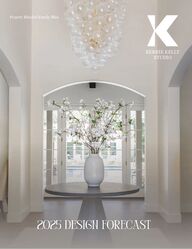
Return to flip book view
Message KERRIE KELLYSTUDIOProject: Blended Family Bliss
LETTER FROM THE DESIGNER03COLOR DRENCHING04HYPER-TACTILE DESIGN06GLOBAL MAXIMALISM08WELLNESS SPACES1012 ALFRESCO LIVING14COZY MINIMALISM
TAKE OUR TREND FORECAST SURVEY HERE 3It’s that time again where designerseverywhere are looking for their nextspark of creative inspiration fromthe hottest trends. Every year, iconic brands useforecasts to anticipate the next wavein design, creating the very productsthat bring these trends to life. Our 2025 Design Forecast is hereand we’re diving deep into SIXhighly anticipated trends discussingwhy they’re emerging, what you maylove (or not!), how to achieve them,and where in the country they willresonate the most . Designerletterfrom theWhat trend are you looking forward to tapping into in 2025? What’d we miss?
Why it’s Emerging:This trend is gaining popularityas people seek to express morepersonality and make bold designstatements in their homes.Advantages and drawbacks: Theadvantage is its high-impact visualeffect, creating depth and moodwithin a space. However, it can beoverwhelming if not balancedproperly with furnishings and decor.Cost: It’s relatively affordable,especially if only using paint, butcoordinating custom furniture oraccessories can increase the cost.ColorDrenchingFirst up, color drenching: where walls, ceilings,and sometimes even furniture are painted inone bold hue to create a dramatic andimmersive experience.
Best suited climates/regions:Beautiful in both colder climateswhere warmth is desired, andsunnier regions where bold colorcan enhance natural light.Ease of installation: Paintingis straightforward, but achievinga cohesive look with furnitureand finishes may require morecareful planning.
Hyper-TactileDesignNext up, we have hyper-tactile design: creatingspaces that extend beyondthe visual elements ofdesign and invite you toengage with them on asensory level. Why it’s emerging: This trend is risingas people crave deeper connections withtheir environments, focusing on howspaces feel rather than just how they look.The move toward biophilic design andsensory engagement reflects a desire forcomfort and natural warmth.Advantages and drawbacks:It creates an immersive, personalatmosphere through textured surfaces andmaterials. However, maintaining heavilytextured spaces can be challenging,especially with fabrics and materials thatwear down or attract dust.
Cost: Costs vary based on thematerials used, with high-end finisheslike terracotta or sculptural wallsbeing pricier. Affordable texturedoptions are available for budget-conscious projects.Ease of installation: Addingtextured decor is simple, butincorporating intricate surfaces likestone or sculptural walls requiresskilled labor.Best suited climates/regions:Regions with natural beauty, likeCalifornia or the Pacific Northwest,where organic textures blendseamlessly with the environment.
GlobalMaximalismThen, we have Global Maximalism: a culturalresponse to shifting from the “minimalistmovement”. Unlike Maximalism as we know it,this style isn’t personality or aesthetics driven,but inspired by worldly travels, blending vibrantpatterns and handcrafted decor to embrace a“more is more” ethos. Why it’s emerging: As people seek toinfuse personality and culturalstorytelling into their homes, this trendreflects a shift away from minimalism. Itcelebrates global craftsmanship, travelinfluences, and cultural diversity.Advantages and drawbacks: GlobalMaximalism allows for creative self-expression and layering of textures andpatterns. However, without carefulcuration, it can feel cluttered or losecohesion with multiple global elements.Cost: Costs depend on the source andauthenticity of decor, with artisan pieceson the higher end. Affordable globallyinspired collections offer budget-friendlyalternatives.
Best suited climates/regions:This trend suits culturally rich andurban areas like Southern California,New York, or internationally diversecities, where global influences thrive.Ease of installation: Installation iseasy as the trend focuses on decor,textiles, and furniture, but ensuringcohesive design with diverse elementsrequires a sharp design eye.
wellness spacesWellness spaces are becoming the ultimate home retreat, with dedicated areaslike meditation rooms, yoga nooks, and even luxury spas, allowing homeownersto prioritize their mental and physical health.Why it’s emerging: Post-pandemic,people are more focused on mental andphysical wellness, which has translatedinto home design. Wellness spaces, likemeditation rooms, home spas, andsaunas, cater to that need.Advantages and drawbacks: Thebiggest advantage is having a personalsanctuary at home that promotesrelaxation and well-being. A drawbackmight be the space required, as not everyhome can accommodate dedicatedwellness rooms.
Cost: This trend can varysignificantly in cost, from a fewhundred dollars for yoga areas totens of thousands for moreluxurious home spas.Ease of installation: Simplewellness spaces, like readingnooks or meditation corners, areeasy to set up, but larger projectslike saunas or home gymsrequire professional installationand structural considerations.Best suited climates/regions:Wellness spaces work in any climatebut are particularly appreciated inregions with harsh weather, whereoutdoor exercise is limited, such ascolder or extremely hot areas.
alfrescolivingIntegrated Alfresco Living is all about creatingseamless transitions between indoor and outdoorspaces, where patios, gardens, and even rooftopsbecome fully functional areas for cooking, dining,and lounging year-round. Think outdoorkitchens, fire pits, and cozy lounges that feel likean extension of the home.Why it’s emerging: With peoplespending more time at home, integratedalfresco living connects interior andexterior spaces seamlessly. This trendenhances outdoor living, making it anextension of the home.Advantages and drawbacks:The benefit is creating a versatilespace for dining, relaxation, andentertainment. However, exposureto the elements can require moredurable materials and maintenance.Cost: High-end integrated alfrescospaces can be pricey, especially withcustom materials, outdoor kitchens,and weather-resistant furniture, butmore modest versions are achievableon smaller budgets.
Best suited climates/regions:This trend thrives in temperateclimates, like the coastal orMediterranean regions. However,with the right materials andplanning, alfresco spaces can beenjoyed anywhere.Ease of installation: Thisdepends on the complexity of thedesign. Simple patio spaces areeasy to install, while fullyintegrated outdoor kitchens andlounges may require professionalconstruction.
cozyminimalismCozy Minimalism pairs clean, simplelines with soft, inviting textures,combining the calm of minimalism withthe warmth of plush furniture, layeredtextiles, and neutral color palettes for aspace that feels both serene and lived-in.Advantages and drawbacks:The beauty of cozy minimalism isthat it creates a calming and clutter-free space while still feeling homely.However, it can be challenging tostrike the right balance betweensparse and too cozy, losing theminimalist aesthetic.Why it’s emerging: Cozyminimalism is on the rise as peopleseek to balance the clean lines ofminimalism with the comfort ofwarmer textures and materials. Itbrings a sense of simplicity whileremaining inviting and liveable.
Cost: Cozy minimalist spacestend to be mid-range in cost, asthe focus is on fewer, high-quality pieces rather thanexcessive decoration.Ease of installation: Thisstyle is fairly easy to achieve, asit focuses on decluttering andcarefully curating decor, thoughselecting the right discreettechnology (like hiddenspeakers or wireless charging)may require more effort.Best suited climates/regions:Cozy minimalism is adaptable toany region but particularlyresonates in colder climates wherewarmth and comfort are essential.
2025 DesignForecastTAKE OUR TRENDFORECAST SURVEY What trend are youlooking forward totapping into in 2025?What’d we miss?